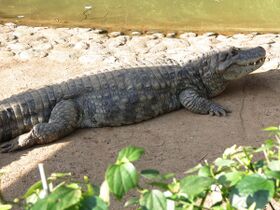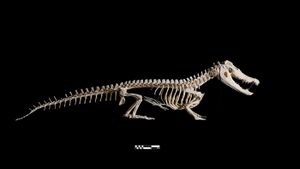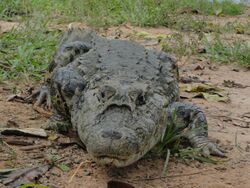Biology:Broad-snouted caiman
| Broad-snouted caiman | |
|---|---|

| |
| Scientific classification | |
| Domain: | Eukaryota |
| Kingdom: | Animalia |
| Phylum: | Chordata |
| Class: | Reptilia |
| Clade: | Archosauromorpha |
| Clade: | Archosauriformes |
| Order: | Crocodilia |
| Family: | Alligatoridae |
| Subfamily: | Caimaninae |
| Clade: | Jacarea |
| Genus: | Caiman |
| Species: | C. latirostris
|
| Binomial name | |
| Caiman latirostris Daudin, 1801
| |

| |
| Broad-snouted caiman range | |
| Synonyms | |
|
Species synonymy
| |
The broad-snouted caiman (Caiman latirostris) is a crocodilian in the family Alligatoridae found in eastern and central South America, including southeastern Brazil , northern Argentina , Uruguay, Paraguay, and Bolivia.[4] It is found mostly in freshwater marshes, swamps, and mangroves, usually in still or very slow-moving waters.[5] It will often use man-made cow ponds.[6]
Characteristics
In the wild, adults normally grow to 2 to 2.5 m (6 ft 7 in to 8 ft 2 in) in length, but a few old males have been recorded to reach up to 3.5 m (11 ft).[5][7] Captive adults have weighed 23 to 65 kg (51 to 143 lb).[8][9] A large adult male of 2.6 m (8 ft 6 in) would weigh around 80 kg (180 lb).[10] Most tend to be of a light olive-green color. A few individuals have spots on their faces.[6] The most notable physical characteristic is the broad snout from which its name is derived.[6] The snout is well adapted to rip through the dense vegetation of the marshes. Due to this, they swallow some of the dense vegetation while foraging for food.[11]

Biology and behavior

The broad-snouted caiman is ectothermic, depending on its external environment to regulate its body temperature. Its heart rate increases as the temperature increases and decreases when the temperature is lowered.[12] The heat of the sun is absorbed through the skin into the blood, keeping its body temperature up. An increased heart rate helps the newly absorbed heat transfer throughout the body more quickly. When the air becomes cooler, the need for the heart rate to remain elevated is lost.[12]
Young caimans rely heavily on their ability to find shelter to avoid predation.[13] This behavior drops off as they age.[13]
Hunting and diet
Its diet consists mainly of small invertebrates, and it can crush shells to feed on turtles and snails[6] (including ampullarid snails).[14] As the size of C. latirostris increases, the size of its prey tends to increase. Young broad-snouted caimans have a diet consisting of mostly insects; however, as the caiman grows, it increases its intake of birds, fish, amphibians,[14] and reptiles.[11][13] Captive specimens have been documented and photographed devouring the fruit of Philodendron bipinnatifidum without external stimulation, though it is unclear if this is because of them being housed with tegu or a natural behaviour.[15] A later study also concluded that C. latirostris and its relatives are obligate omnivores, and play an important role in the dispersal of plant seeds in their habitats.[16]
Reproduction

The female lays 18 to 50 eggs at a time. While rare, up to 129 eggs have been found within a single nest, presumably from several layings.[5] They lay their eggs in two layers, with a slight temperature difference between the two layers. This will result in a more even ratio of males and females.[6] The caiman does not have sex chromosomes, but instead depends on temperature to determine the ratio of male and female offspring. Eggs at warmer temperatures (32 °C (90 °F) or higher) develop into males and eggs at cooler temperatures (31 °C (88 °F) or lower) develop into females.[17] Estrogen levels and stress levels of the mother can have an effect. Nests reared at the same temperature can differ in sex ratio. This indicates there are other factor that contribute to a nest having male or female eggs.[18]
Conservation
Hunting of the species began in the 1940s. Its skin is greatly valued for its smooth texture. Until most countries made hunting them illegal, this was the largest threat to the broad-snouted caiman. The ban on hunting helped them to regain their population.[5] The new threat is habitat destruction.[5] Deforestation and pollution run-off are the two leading causes to the destruction of their habitat.[6]
The species is well known from the lagoons of the urban areas of Barra da Tijuca and Recreio dos Bandeirantes in Rio de Janeiro.
Notes
- ↑ Except populations of Argentina and Brazil which are included in Appendix II.
References
- ↑ Rio, Jonathan P.; Mannion, Philip D. (6 September 2021). "Phylogenetic analysis of a new morphological dataset elucidates the evolutionary history of Crocodylia and resolves the long-standing gharial problem". PeerJ 9: e12094. doi:10.7717/peerj.12094. PMID 34567843.
- ↑ Siroski, P.; Bassetti, L.A.B.; Piña, C.; Larriera, A. (2020). "Caiman latirostris". IUCN Red List of Threatened Species 2020: e.T46585A3009813. doi:10.2305/IUCN.UK.2020-3.RLTS.T46585A3009813.en. https://www.iucnredlist.org/species/46585/3009813. Retrieved 19 November 2021.
- ↑ "Appendices | CITES". https://cites.org/eng/app/appendices.php.
- ↑ Crocodile Specialist Group (1996). "Caiman latirostris". IUCN Red List of Threatened Species 1996: e.T46585A11062418. doi:10.2305/IUCN.UK.1996.RLTS.T46585A11062418.en. https://www.iucnredlist.org/species/46585/11062418.
- ↑ 5.0 5.1 5.2 5.3 5.4 "Broad-snouted Caiman Caiman latirostris". Crocodiles. Status Survey and Conservation Action Plan. (3 ed.). Darwin, Australia: Crocodile Specialist Group. 2022-01-19. pp. 18–22. http://www.iucncsg.org/365_docs/attachments/protarea/04_C-c7ff4560.pdf. Retrieved 2022-03-02.
- ↑ 6.0 6.1 6.2 6.3 6.4 6.5 Britton, A. Caiman latirostris (Daudin, 1801). Crocodilian Species List.http://www.flmnh.ufl.edu/cnhc/csp_clat.htm. 2009.
- ↑ "3.3 Caimans". http://www.fao.org/docrep/T0750E/t0750e0b.htm.
- ↑ "Archived copy". http://docentes.esalq.usp.br/lea/Artigos_pdf/Verdade%202003.pdf.
- ↑ Bassetti, Luís AB; Marques, Thiago S.; Malvásio, Adriana; Piña, Carlos I.; Verdade, Luciano M. (4 February 2014). "Thermoregulation in captive broad-snouted caiman (Caiman latirostris)". Zoological Studies 53 (1): 9. doi:10.1186/1810-522X-53-9. ISSN 1810-522X.
- ↑ Liwszyc, Guillermo; Larramendy, Marcelo L. (10 February 2023) (in en). Bird and Reptile Species in Environmental Risk Assessment Strategies. Royal Society of Chemistry. ISBN 978-1-83767-077-2. https://books.google.com/books?id=HKetEAAAQBAJ.
- ↑ 11.0 11.1 Borteiro, C. Gutierrez, F. Tedros, M. and Kolenc, F. Food habits of the Broad-snouted Caiman (Caiman Latirostris:Crocodylia, Alligatoridae) in northwestern Uruguay. Studies on Neotropical Fauna and Environment. Vol. 44, No. 1, April 2009, 31-36.
- ↑ 12.0 12.1 Micheli, M.A. Campbell, H. A. Autonomic control of heart rate exhibits diurnal shifts in a crocodilian. Amphibia-Reptilia, Vol. 29 Issue 4, 2008. 567-571.
- ↑ 13.0 13.1 13.2 Somaweera, Ruchira; Brien, Matthew; Shine, Richard (2013-12-01). "The Role of Predation in Shaping Crocodilian Natural History". Herpetological Monographs (Herpetologists League) 27 (1): 23. doi:10.1655/herpmonographs-d-11-00001. ISSN 0733-1347.
- ↑ 14.0 14.1 "Crocodilian Species - Broad-snouted Caiman (Caiman latirostris)". https://crocodilian.com/cnhc/csp_clat.htm.
- ↑ Brito et al. 2002. "Do caiman eat fruit?".http://www.rc.unesp.br/ib/zoologia/denis/Brito_et_al.pdf. 2002.
- ↑ Platt, S.G; Elsey, R.M; Liu, H. (2013). "Frugivory and seed dispersal by crocodilians: an overlooked form of saurochory?". Journal of Zoology 291 (2): 87–99. doi:10.1111/jzo.12052.
- ↑ María Virginia Parachú Marcó, Pamela Leiva, Josefina Luciana Iungman, Melina Soledad Simoncini and Carlos Ignacio Piña (April 2017): New Evidence Characterizing Temperature-dependent Sex Determination in Broad-snouted Caiman, Caiman latirostris.
- ↑ Simoncini, Melina (2019). "Influence of Temperature Variation on Incubation Period, Hatching Success, Sex Ratio, and Phenotypes in Caiman Latirostris". Experimental Zoology Part A:Ecological and Integrative Physiology 331 (5): 299–307. doi:10.1002/jez.2265. PMID 31033236.
Wikidata ☰ Q644453 entry
 |


